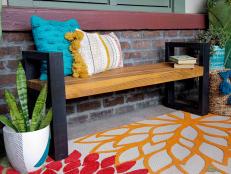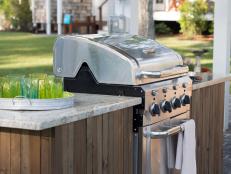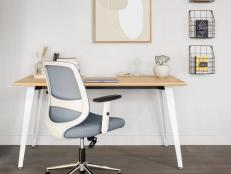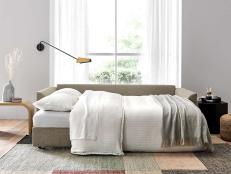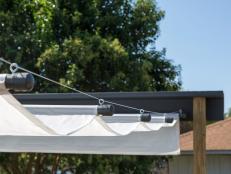Build an Entertainment Center
When it comes to vertical storage, it doesn't get much better than an entertainment center. If you want to build your own, here's how:
Materials:
table saw
¾-inch and ¼-inch plywood
circular saw
tape measure
chalk line
2-by-4-inch lumber
carpenter's pencil
pneumatic nailer
1½-inch finishing nails
wood glue
wood dowels
doweling jig
clamps
¾-inch brads
1-inch screws
poplar wood (1 by 6 inches, 1 by 4 inches, and a strip for the face of the top shelf)
miter saw
jigsaw
biscuit joiner
trim molding
220-grit sandpaper
palm sander
primer
paint
paintbrushes and nap roller
door hinges
doorknobs
Steps:
The Frame
- Using a table saw, rip the ¾-inch plywood into 23-inch pieces for the top, the bottom and the two sides. These pieces will form the frame of the unit. With a circular saw, cut two pieces of plywood to lengths of 47 inches for the top and bottom of the cabinet. Cut the two side pieces of the cabinet to 66 inches long. Make sure that the long edges of these pieces are straight. Finally, cut five pieces of 2-by-4 to length. These will form the bottom frame of the entertainment center.
- Measure in 6½ inches on each side of the bottom and mark the location by drawing a line. Attach the two sides of the cabinet, applying glue and then nailing the pieces together with a pneumatic nailer loaded with finishing nails. Don't make more nail holes than necessary! Repeat the procedure to attach the top pieces, assembling the pieces at the marked locations, and then glue and nail them together.
- Attach the 2-by-4 bottom frame with glue and nails. Then fasten four heavy-duty top plates to the bottom and screw on decorative feet to accentuate the unit.
Face Frame and Back
- Attach the two side face frames, gluing and then nailing the pieces together. Measure and cut the front face frame. Mark the location for the dowel holes and then use a doweling jig to drill the holes. The jig keeps the holes aligned and the same depth in each piece.
- Squeeze wood glue into each hole on one side of the frame, and then hammer the wood dowels into the holes. Carefully align the wood dowels with the bored holes and press them into position. Clamp the frames together, check the assembly to make sure it's square and set it aside to dry.
- Once the unit is dry, position the front face frame so that the edges are flush, and then attach them to the unit.
- Install the back-a piece of ¼-inch plywood-and secure it with ¾-inch brads.
Cleats
- Measure for the length of the cleats to be attached to the unit. Using a circular saw, cut the cleats to length, and then drill pilot holes into them.
- Attach the cleats to the unit with glue and 1-inch screws. Glue a strip of poplar to cover the face of the top shelf. Add a center brace to the top shelf to help support the weight of a television set.
Drawer
- Take measurements for the drawer and transfer them to 1-by-6 poplar. Using a miter saw, cut the four pieces for the front, back and sides of the drawer. Cut the drawer bottom to size on the table saw. Use the table saw to cut ¼-inch dado grooves into all four of the side pieces-these will be used to slide in the bottom of the drawer.
- To create a pull for the drawer, lay out the area to be cut with a pencil and use a jigsaw to make the cut.
- Sand off the rough areas of all the pieces of the drawer.
- Use glue and 1½-inch finishing nails to assemble three of the sides of the drawer. Once the first three sides are joined, apply wood glue to dado grooves and slide the drawer bottom into place. Attach the fourth side of the drawer with glue and finishing nails.
- Attach slides to the interior of the cabinet, and then attach the drawer to slides.
Shelves and Doors
- Attach both shelves with glue and a pneumatic nailer.
- Take measurements for the door and transfer them to 1-by-4 poplar and make the cuts. Use a biscuit joiner to cut slots in the door pieces. Place glue in the joints, insert the biscuits and clamp the pieces together to dry.
- After the frame is dry, make router cuts inside the back of the frame and insert ¼-inch plywood into the opening.
- Cut molding pieces for the doors to size, mitering the ends and rounding the edges with a router. Glue and nail the trim molding in place.
- Dry-fit the doors and measure for clearance.
- Install the bottom spacers inside the unit, attaching them with small finishing nails.
- Nail the top shelf to the spacers that will hold the television set.
Finishing
- Using 220-grit sandpaper, sand all the wood surfaces.
- To make cutouts in the back of the unit so that cables and wires can be fed through, drill two holes and then use a jigsaw to cut out the area between the holes.
- Take measurements for moldings for the top and bottom of the unit. Position the top trim pieces flush with the top edge. Using a pneumatic nailer, attach the first piece of trim. Be sure to keep the overhang at ¾-inch. Attach the second piece of trim to the top of the cabinet, and then nail the bottom trim piece in place, being careful to keep the trim flush with the edges.
- Prime the unit and allow the primer to dry. Then use a palm sander with 220-grit sandpaper to smooth all the wood surfaces and prepare it for the paint. The primer raises the wood grain, so it's important to sand again to smooth the surfaces.
- Use a small roller to spread navy blue paint on the interior walls of the cabinet. Paint the shelves before attaching them. After the first coat of paint has dried, apply a second coat. It's recommended that when painting with dark colors you apply two or three coats
- Paint the exterior white, starting with a short-nap roller. Smooth the paint with a trim brush, and then apply white enamel paint to the exterior trim molding.
- Lay the doors over sawhorses and paint them with brushes. After the top coat dries, paint the other side of the doors.
- Drill pilot holes in the doors, and then attach the hinges with the supplied screws. Hold each door in place and attach the hinges to the cabinet with screws.
- Mark the location for the doorknobs on each door and pre-drill holes for the hardware. Attach the doorknob with the provided screw. Repeat the process on the other door.






